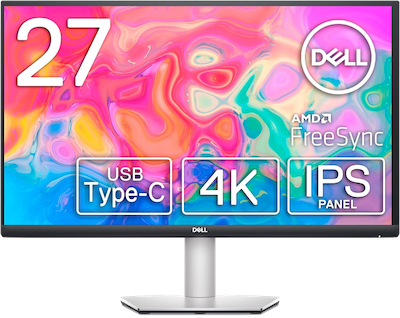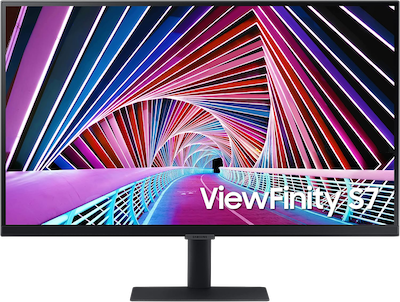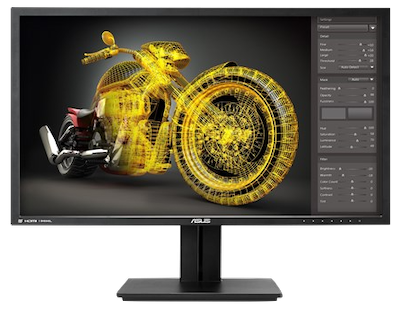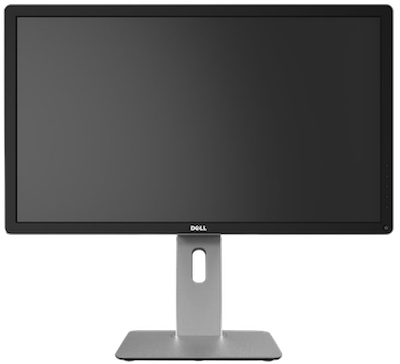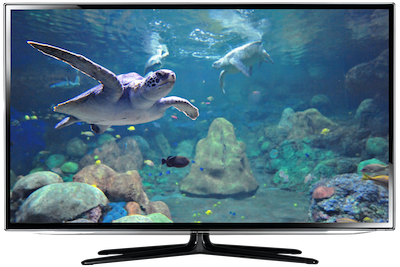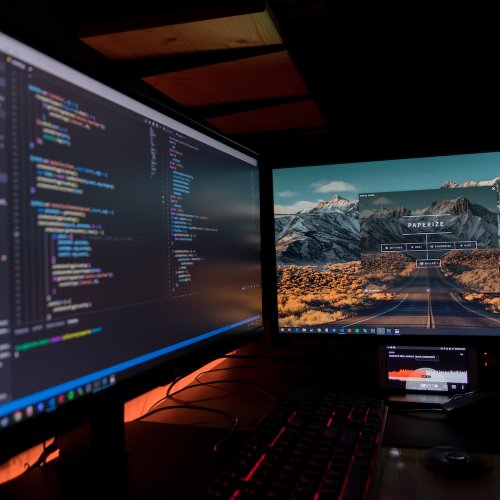Displays
A guide to Displays
TL;DR – What's the obsession with external displays?
Laptop screens are small, as they should be; the smaller, the better. However, when undertaking serious work, expanding your canvas is almost always a positive thing. You'll be able to organize your work and interact with software without having to Alt-Tab through programs or remember on which virtual destop you parked a window. As an engineer, it's typical to need multiple screens of information viewable at one time to be most effective. While having multiple screens may seem like a "luxury", this is a luxury every engineer should seek to afford.
TL;DR – Just Tell Me Which Display to Buy!
In early 2025, if you live in the UAE, purchase either the Dell S2722QC 27-inch 4K (1410 AED) or the Samsung 27-inch ViewFinity 4K (979 AED). Dell is better. If you're more budget-sensitive, try searching Amazon for 4K displays larger than 26-inches:
TL;DR – Using Shared Displays in the Lab
- Displays in the EDS are community resources - don't change ANY hardware settings.
- Keys are locked on all displays for a reason: see #1.
- Use the appropriate cables and ports to achieve 60Hz performance at full, native resolution. No 30Hz setups allowed.
- Don't hoard all the "best" displays - use displays that work well with your computer.
- All displays have been configured to work decently well with the sRGB color profile.
- Customization and Personalization must be done via software on your computer, not in the display's settings. (MacOS, Windows, Linux).
TL;DR – Advice on Purchasing Displays for Personal Use
There are three main categories to choose from, portable, tablet, or desktop:
- Portable Display. Look for a USB-C Powered 13-inch/14-inch/15-inch display with 4K resolution, 60Hz. Prices will be $200 to $300. Avoid 1080p at this small screen size, even though they'll be much cheaper; the typical viewing distance to a laptop screen or portable display is 16 to 18 inches, meaning the individual pixels of a 15-inch 1080p portable display will be visible (at typical viewing distances) and lead to eye strain. Be especially cautious of very affordable displays being advertised as "4K compatible 1080p" – these are typically just 1080p screens being falsely advertised as "4K".
- Tablet. Many of the most popular manufacturers of tablets have created software solutions to use those devices as an external display when connected to a laptop or mobile phone. If considering the purchase of a tablet, research whether it is compatible with your existing devices to become a portable external display. Both Apple and Samsung have developed these features natively for their tablets, and there are also dozens of third-party apps that mimick similar functionality.
- Desktop Display. Use tools to understand and select good visual properties of displays you're considering. While 4k60 is typically the gold standard for office work, pixel density more than just raw pixel count is what matters. A 21-inch 1080p display and a 40-inch 4K screen have the same number of pixels per inch, but the viewing experience will be very different.
A "Goldilocks" monitor will typically be a 27-inch to 32-inch 4k60 (3840x2160 @ 60Hz) panel with modern connections like USB-C (with power pass-through), DisplayPort 1.4 and/or higher, or HDMI 2.0 or higher.
Prices for 4K screens can range from $300 to $800 AVOID ULTRA-WIDESCREEN CURVED DISPLAYS. If your computer supports two external 4K displays, two screens will typically be more useful than one wrap-around, curved screen, as the vertical resolution of ultra-widescreen displays is usually quite low, 1080px or 1440px. When trying to do actual work, vertical pixels are a premium worth paying for. (Also, avoid using TVs as displays), even though it's possible to disable all the annoying "TV Features" and tweak settings to force a TV to behave like a monitor, the experience will typically be worse than using a device specifically designed to be a computer monitor.
The Display Specifications, Versus, and PC Part Picker websites offer good search and filtering tools. Here is a (pre-filtered list of candidate displays with reasonable specifications) on PC Part Picker. (note: Adding "HDMI" and "DisplayPort" to the "Interfaces" section will increase the available hardware options)
The overall challenge is to find a "good" screen that works well in these four categories:- Works with the ports available on your computer.
- Physically fits on your desk.
- Has good pixel density at the expected viewing distance (~60 Pixels Per Degree)
- Fits your budget.
Introduction to Displays in the Engineering Design Studio
Displays are a wonderfully complex issue (resolution, screen size, curved/flat, aspect ratio, color profile, refresh rate, PPI, PPD, etc), but thankfully, for the sake of this guide, the EDS has only a handful of different display types and configurations that generally operate in the same way, with only small variations.
The guiding principle is:
displays are community resources. No one should change any hardware settings.
Therefore, at all times, all displays must remain in well-known, standard configurations and be available for use by anyone, with any computer, without need to change or reset any hardware settings on the displays. Essentially, users are not supposed to customize the displays, as doing so leaves the display in an unknown state that is potentially annoying or unusable for the next person encountering it. All "personalization" must be done by changing settings on a user's computer, not on the display.
NOTE: Keys are locked on all displays to prevent changing settings of the display. See the "Personalization" section below for ways to have a custom experience that doesn't impact others' abilities to use the display.
Connections & Cables
While everyone wants to use the "best" display, there are some factors to consider before simply grabbing what seems to be the biggest or "best" display and connecting it to your computer. Generally speaking, there are three categories of displays in the EDS:
- Ultra-HD Monitors (3840x2160@60Hz, aka 4k60)
- HD Televisions (1920x1080@60Hz, aka 1080p60)
- WUXGA Monitors (1920x1200@60Hz)
Any display being used should be connected to a computer able to maximally utilize the display's capabilities (i.e. run at full resolution and 60Hz, not a degraded 30Hz).
Display Hardware in the EDS
ASUS 28" Ultra-HD 4k60 (PB287Q)
For ASUS 28" (PB287Q) Monitors (Locked to use the DisplayPort input ONLY):
- These are 4k60Hz Computer Monitors.
- These displays can only reproduce 4k60Hz performance when connected via the DisplayPort connection (locked to use DisplayPort input).
- For modern laptops, use a USB-C to DisplayPort cable or a USB-C to DisplayPort hub with power delivery pass-through. Verify that the refresh rate is 60Hz.
- If your computer does not have a Thunderbolt 3/4 USB-C port or a DisplayPort 1.2 or above port, please don't use these monitors, as other computers with higher specifications are able to use them at full 4k resolution and a 60Hz frame rate.
- Please do not use these displays via HDMI. This is a degraded performance mode that should be avoided, as these displays do not implement the HDMI 2.0 protocol required for 4k60Hz operation.
- When using multiple displays connected to a single computer, it's common that only one of these Asus monitors will perform at 60Hz and the second will be at 30Hz. This is an issue with the Thunderbolt protocol; Thunderbolt 3 can only drive a single display at 4k60Hz, and Thunderbolt 4 can drive two displays at 4k60Hz. Please ensure your computer has Thunderbolt 4 before attempting to utilize two of these displays at 4k60. (also, it's a bit extra to use two of the limited quantity of 4k displays in the lab; consider a blend of one 4k display and one 1080p display)
- Optimal viewing distance (Pixels Per Degree ~60) for the ASUS 28" (PB287Q) UHD display, at 100%, is: 48cm / 19in
- Optimal viewing distance (Pixels Per Degree ~60) for the ASUS 28" (PB287Q) UHD display, scaled to 150%, is: 79cm / 31in
- Optimal viewing distance (Pixels Per Degree ~60) for the ASUS 28" (PB287Q) UHD display, scaled to 200%, is: 107cm / 42in
- Desks in the EDS are setup with a typical distance from the display of 30in to 35in (76cm to 91cm), depending on posture. Hence, it's advisable to use the Asus 28" UHD display at a distance of 31in / 79cm with the scaling factor set to 150% within your Operating System.
Dell 24" Ultra-HD 4k60 (UP2414Qt)
For Dell 24" UHD (UP2414Qt) Monitors (Locked to use the DisplayPort input ONLY):
- These are 4k60Hz Computer Monitors.
- These displays can only reproduce 4k60Hz performance when connected via the DisplayPort or MiniDisplayPort connections (locked to use DisplayPort input).
- For modern laptops, use a USB-C to DisplayPort cable or a USB-C to DisplayPort hub with power delivery pass-through. Verify that the refresh rate is 60Hz.
- If your computer does not have a Thunderbolt 3/4 USB-C port or a DisplayPort 1.2 or above port, please don't use these monitors, as other computers with higher specifications are able to use them at full 4k resolution and a 60Hz frame rate.
- Please do not use these displays via HDMI. This is a degraded performance mode that should be avoided, as these displays do not implement the HDMI 2.0 protocol required for 4k60Hz operation.
- When using multiple displays connected to a single computer, it's common that only one of these Dell monitors will perform at 60Hz and the second will be at 30Hz. This is an issue with the Thunderbolt protocol; Thunderbolt 3 can only drive a single display at 4k60Hz, and Thunderbolt 4 can drive two displays at 4k60Hz. Please ensure your computer has Thunderbolt 4 before attempting to utilize two of these displays at 4k60. (also, it's a bit extra to use two of the limited quantity of 4k displays in the lab; consider a blend of one 4k display and one 1080p display)
- Optimal viewing distance (Pixels Per Degree ~60) for the Dell 24" (UP2414Qt) UHD display, at 100%, is: 42cm / 17in
- Optimal viewing distance (Pixels Per Degree ~60) for the Dell 24" (UP2414Qt) UHD display, scaled to 150%, is: 68cm / 27in
- Optimal viewing distance (Pixels Per Degree ~60) for the Dell 24" (UP2414Qt) UHD display, scaled to 200%, is: 91cm / 36in
- Desks in the EDS are setup with a typical distance from the display of 30in to 35in (76cm to 91cm), depending on posture. Hence, it's advisable to use the Dell 24" display at a distance of 27in to 36in (68cm to 91cm) with the scaling factor set to between 150% and 200% within your Operating System.
Dell 24" WUXGA (U2412Mc/b)
For Dell 24" (U2412Mc/b) WUXGA Monitors (Auto-selects input. Prefer HDMI/DVI or DisplayPort):
- These are roughly similar to 1080p60Hz displays, except they have a 16:10 aspect ratio and produce 1920x1200 pixels at 60Hz (WUXGA).
- These displays can produce full-performance when connected using any of the 3 ports available (DisplayPort, HDMI/DVI, VGA).
- For modern laptops, it's preferred to connect via HDMI and use a Thunderbolt 3/4 USB-C hub with HDMI output that allows laptop charging through the hub. The EDS has a number of USB-C hubs with sufficient specifications.
- While it's possible to connect via DisplayPort, these displays don't require DisplayPort to perform at maximum levels. The EDS has a small number of USB-C to DisplayPort hubs with power delivery pass-through to allow laptop charging and video over a single cable; however, these hubs are prioritized to be used with the Ultra-HD displays that require DisplayPort to perform at the highest specifications.
- Optimal viewing distance (Pixels Per Degree ~60) for the Dell 24" (U2412Mc/b), at 100%, is: 90cm / 35in
- Desks in the EDS are setup with a typical distance from the display of 30in to 35in (76cm to 91cm), depending on posture. Hence, the Dell 24" (U2412Mc/b) is nearly perfectly suited for typical desk usage, without need for special Operating System level pixel-scaling considerations.
Samsung 32" HD TV 1080p60 (UA32ES6200R)
NOTE: Even though these are the physically largest displays in the EDS, they have the worst visual performance characteristics and will likely cause eye strain with extended use.
For Samsung 32" HD TV (UA32ES6200R) (Locked to use HDMI1 input ONLY):
- These are 1080p60Hz televisions.
- They can produce 1920x1080 @ 60Hz via any of their HDMI inputs. However, the keys of all displays have been locked and HDMI1 is the selected input.
- For modern laptops, connect via HDMI and use a Thunderbolt 3/4 USB-C hub with HDMI output that allows for laptop charging through the hub. The EDS has a number of USB-C hubs with sufficient specifications.
- Optimal viewing distance (Pixels Per Degree ~60) for the Samsung 32" TV (UA32ES6200R), at 100%, is: 124cm / 49in
- Desks in the EDS are setup with a typical distance from the display of 30in to 35in (76cm to 91cm), depending on posture. Hence, it's advisable to only use the Samsung TVs on the larger "Stage Deck" tables that are 100cm deep and to place the TV as far away as possible.
Connecting Multiple Monitors
TL;DR - Use, at most, one 4k60Hz display (USB-C to DisplayPort or Thunderbolt 3/4 Hub with DisplayPort) and one 1920x1200@60Hz (USB-C Hub w/charging via HDMI)
Again, it's tempting to grab as many of the "best" monitors to have the "ultimate" setup. However, given protocol limitations, it often won't be possible to use multiple 4k60Hz monitors on the same machine and maintain the highest performance levels (60Hz refresh rate).
The limiting factor on laptop computers, at the time of writing, is the Thunderbolt version. Thunderbolt 3, even when multiple Thunderbolt-3-enabled USB-C ports are available, can only support a single 4k60Hz display. Thunderbolt 4, a protocol standard that has become more widely included in hardware from around 2020 onwards, can support two 4k60Hz displays.
While 4k resolution is an absolute joy to look at compared with 1080p on displays of the same dimensions (and at optimal viewing distances), a second, crucial factor that produces a "modern" and "responsive" feel is the refresh rate. Using a monitor at 30Hz will feel like being in the 1990's. Ensuring all connected monitors are operating at 60Hz will make your computing experience perceptibly better.
Additionally, most modern laptops allow charging via USB-C, and depending on the specific hardware in use, that same USB-C port can be used for many other things while charging. Hence, it often makes sense to connect a multi-functional USB-C hub that allows charging pass-through while also exposing a number of other ports and functionalities (e.g. HDMI, Ethernet, USB-A, SD Card Reader, Charging, etc).
Unfortunately, at the time of writing this, most of the "affordable" ($50 or less), multi-functional USB-C hub devices that provide charging pass-through typically only expose an HDMI connection, not DisplayPort. Since all of the EDS 4k60Hz monitors do not support 4k60Hz over HDMI, please do not use HDMI with 4k60Hz UltraHD displays.
A typical multi-monitor setup includes one 4k60Hz monitor connected via USB-C to DisplayPort cable and one 1920x1200@60Hz display connected via the USB-C hub and HDMI, allowing charging of a laptop via hub. Note: the EDS has a small number of Thunderbolt 3/4 USB-C to DisplayPort hubs with Power Delivery pass-through; these are reserved for use with the UltraHD monitors at 4k60Hz and should not be used in 1080p60Hz configurations.
For more complex multi-monitor setups, please contact hello@nyuad.io to discuss selecting appropriate hardware and connection pathways.
Display Color Profiles
All displays in the Engineering Design Studio have been configured to work well with the sRGB color profile that is widely available on MacOS, Windows, and Linux.
Selecting the sRGB color profile in MacOS:
- Change your Mac display’s color profile: "In Displays settings, you can switch between different color profiles."
Selecting the sRGB color profile in Windows:
- How to get correct color profile for your monitor on Windows 11
- About Color Management, Windows 7/8.1/10
Selecting the sRGB color profile in Xubuntu Linux:
Selecting the sRGB color profile in Pop!_OS Linux:
- Pop!_OS Documentation: Color Profiles: Options to configure color profiles for displays are found in Settings > Color. Color profile presets allow the user to control how displays represent colors.
Customization and Personalization
If you'd like to "dim" the display or "get rid of blue light" (as is all the rage in 2023), you can make the desired visual tweaks by using software on your computer. By developing a personal "workflow" that utilizes the tools below, one should be able to have a personalized experience with whichever display used and never have to worry about changing display hardware settings ever again.
Screen Brightness Control
Note: DDC/CI has been disabled on all monitors and displays. It is a very powerful protocol for use with a personal monitor, allowing direct adjustment of monitor hardware settings from a desktop application. However, as displays are shared by multiple users in the EDS, these protocols have been disabled. All software that controls brightness needs to achieve this effect by other means. The recommended software options below have been tested to work as dimmers and do not require the DDC/CI protocol. These tools are extremely useful in situations beyond the EDS, as well, since they do not require special access to hardware settings on a display and also do not make any persistent changes to the connected display.
- MacOS: MonitorControl (GitHub Releases): Controls your external display brightness and volume. Use menulet sliders or the keyboard, including native Apple keys!
- Windows: Dimmer: Dimmer is a small and free application for Windows, designed to help you adjust the brightness of your computer screen, monitor or display.
- Linux: Brightness Controller: Brightness Controller is an innovative, open-source software solution designed specifically for Ubuntu users who seek enhanced control over their display settings.
sudo apt update && sudo apt upgrade sudo add-apt-repository ppa:apandada1/brightness-controller -y sudo apt update sudo apt install brightness-controller
Screen Color Temperature Shifting
While eye drops, regular breaks, and eye exercises are generally more preferred solutions for managing screen-induced eye strain, there is an ever-growing movement that demonizes and scapegoats blue light and seeks to remove it from their lives. Fair enough, but again, instead of imposing personal beliefs and preferences on others by changing hardware settings on monitors, it's more practical to change these setting on one's own computer.
- Cross-Platform: f.lux - For those who remember a time when hating blue light was a fringe activity, you may want to stick with what you're familiar with. f.lux is the original third-party blue-light-vacuum that started the whole trend. It's still available today, despite many operating systems incorporating the same feature into their core offerings. Available for MacOS, Windows, Linux, iOS, Android.
- MacOS: Modern releases of MacOS have a "Night Shift" feature built-in to the operating system. This allows for both manual and automatic control of the color temperature to suit a user's needs. Search for it in MacOS settings.
- Windows: Modern releases of Windows 10/11 have a "Night Light" (previously Night Time) feature built-in to the operating system. This allows for both manual and automatic control of the color temperature to suit a user's needs. Search for it in the Windows settings.
- Linux (Pop!_OS): Current releases (22.04) of Pop!_OS include a "Night Light" feature built-in to the operating system. This allows for both manual and automatic control of the color temperature to suit a user's needs. Search for it in the Pop!_OS system settings.
- Linux (Xubuntu): Redshift is an application that adjusts the computer display's color temperature based upon the time of day.
sudo apt update && sudo apt upgrade sudo apt install redshift redshift-gtk
حقوق الطبع والنشر © 2025 المؤلفين الأصلي. كل الحقوق محفوظة.



